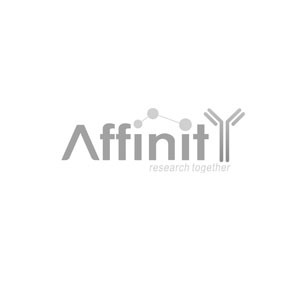CEACAM6 Antibody - #DF8029
| Product: | CEACAM6 Antibody |
| Catalog: | DF8029 |
| Description: | Rabbit polyclonal antibody to CEACAM6 |
| Application: | WB IHC |
| Reactivity: | Human, Mouse, Rat |
| Mol.Wt.: | 37 kDa; 37kD(Calculated). |
| Uniprot: | P40199 |
| RRID: | AB_2841397 |
Related Downloads
Protocols
Product Info
*The optimal dilutions should be determined by the end user.
*Tips:
WB: For western blot detection of denatured protein samples. IHC: For immunohistochemical detection of paraffin sections (IHC-p) or frozen sections (IHC-f) of tissue samples. IF/ICC: For immunofluorescence detection of cell samples. ELISA(peptide): For ELISA detection of antigenic peptide.
Cite Format: Affinity Biosciences Cat# DF8029, RRID:AB_2841397.
Fold/Unfold
Carcinoembryonic antigen related cell adhesion molecule 6; Carcinoembryonic antigen related cell adhesion molecule 6 (non specific cross reacting antigen); Carcinoembryonic antigen-related cell adhesion molecule 6; CD 66c; CD66c; CD66c antigen; CEA LIKE PROTEIN; CEACAM 6; CEACAM6; CEAL; CEAM6_HUMAN; MGC93832; NCA; Non specific cross reacting antigen; Non-specific crossreacting antigen; Normal cross reacting antigen; Normal cross-reacting antigen;
Immunogens
Expressed in neutrophils (PubMed:1378450). Expressed in columnar epithelial and goblet cells of the colon (PubMed:10436421). Expressed in numerous tumor cell lines (at protein level) (PubMed:16204051).
- P40199 CEAM6_HUMAN:
- Protein BLAST With
- NCBI/
- ExPASy/
- Uniprot
MGPPSAPPCRLHVPWKEVLLTASLLTFWNPPTTAKLTIESTPFNVAEGKEVLLLAHNLPQNRIGYSWYKGERVDGNSLIVGYVIGTQQATPGPAYSGRETIYPNASLLIQNVTQNDTGFYTLQVIKSDLVNEEATGQFHVYPELPKPSISSNNSNPVEDKDAVAFTCEPEVQNTTYLWWVNGQSLPVSPRLQLSNGNMTLTLLSVKRNDAGSYECEIQNPASANRSDPVTLNVLYGPDGPTISPSKANYRPGENLNLSCHAASNPPAQYSWFINGTFQQSTQELFIPNITVNNSGSYMCQAHNSATGLNRTTVTMITVSGSAPVLSAVATVGITIGVLARVALI
PTMs - P40199 As Substrate
| Site | PTM Type | Enzyme | Source |
|---|---|---|---|
| N197 | N-Glycosylation | Uniprot | |
| N224 | N-Glycosylation | Uniprot | |
| S243 | Phosphorylation | Uniprot | |
| S304 | Phosphorylation | Uniprot | |
| T312 | Phosphorylation | Uniprot | |
| S326 | Phosphorylation | Uniprot | |
| T330 | Phosphorylation | Uniprot |
Research Backgrounds
Cell surface glycoprotein that plays a role in cell adhesion and tumor progression. Intercellular adhesion occurs in a calcium- and fibronectin-independent manner. Mediates homophilic and heterophilic cell adhesion with other carcinoembryonic antigen-related cell adhesion molecules, such as CEACAM5 and CEACAM8. Heterophilic interaction with CEACAM8 occurs in activated neutrophils. Plays a role in neutrophil adhesion to cytokine-activated endothelial cells. Plays a role as an oncogene by promoting tumor progression; positively regulates cell migration, cell adhesion to endothelial cells and cell invasion. Also involved in the metastatic cascade process by inducing gain resistance to anoikis of pancreatic adenocarcinoma and colorectal carcinoma cells.
Glycosylated.
Cell membrane>Lipid-anchor. Apical cell membrane. Cell surface.
Note: Localized to the apical glycocalyx surface.
Expressed in neutrophils. Expressed in columnar epithelial and goblet cells of the colon. Expressed in numerous tumor cell lines (at protein level).
Homodimer; homodimerizes via its Ig-like V-type domain. Heterodimer with CEACAM8; heterodimerizes via its Ig-like V-type domain.
The extracellular N-terminus Ig-like V-type domain is necessary for homophilic and heterophilic intercellular adhesion.
Belongs to the immunoglobulin superfamily. CEA family.
Restrictive clause
Affinity Biosciences tests all products strictly. Citations are provided as a resource for additional applications that have not been validated by Affinity Biosciences. Please choose the appropriate format for each application and consult Materials and Methods sections for additional details about the use of any product in these publications.
For Research Use Only.
Not for use in diagnostic or therapeutic procedures. Not for resale. Not for distribution without written consent. Affinity Biosciences will not be held responsible for patent infringement or other violations that may occur with the use of our products. Affinity Biosciences, Affinity Biosciences Logo and all other trademarks are the property of Affinity Biosciences LTD.
